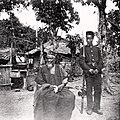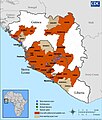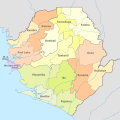Portal:Sierra Leone
The Sierra Leone Portal  Sierra Leone, officially the Republic of Sierra Leone, is a country on the southwest coast of West Africa. It shares its southeastern border with Liberia and is bordered by Guinea to the north. With a land area of 71,740 km2 (27,699 sq mi), Sierra Leone has a tropical climate and with a variety of environments ranging from savannas to rainforests. According to the 2015 census, Sierra Leone has a population of 7,092,113, with Freetown serving as both the capital and largest city. The country is divided into five administrative regions, which are further subdivided into 16 districts. Sierra Leone is governed as a presidential republic, with a unicameral parliament and a directly elected president. Sierra Leone is a secular state with the constitution providing for the separation of state and religion and freedom of conscience, encompassing freedom of thought and religion. Muslims constitute three-quarters of the population with a significant Christian minority. Notably, religious tolerance is very high, reflecting a social norm and part of the nation's cultural identity. Sierra Leone's current territorial configuration was established by the British Empire through two historical phases: initially, the coastal Sierra Leone Colony was founded in 1808 to resettle returning Africans following the abolition of the slave trade; subsequently, the inland Protectorate was created in 1896 in the wake of the Berlin Conference of 1884–1885. This led to the formal recognition of the territory as the Sierra Leone Colony and Protectorate, or British Sierra Leone. Independence from the United Kingdom was attained in 1961, with Sierra Leone transitioning into a Commonwealth realm as the Dominion of Sierra Leone under the leadership of Prime Minister Sir Milton Margai of the Sierra Leone People's Party (SLPP). Under prime minister Siaka Stevens of the All People's Congress (APC), the country adopted a new constitution in 1971, transforming Sierra Leone into a presidential republic with Stevens as the inaugural president. After declaring the APC the sole legal party in 1978, Stevens was succeeded by Joseph Saidu Momoh in 1985. Momoh's enactment of a new constitution in 1991 reintroduced a multi-party system. That year, a protracted civil war initiated, featuring the government and the Revolutionary United Front (RUF) rebel group, leading to significant turmoil. The conflict, characterized by multiple coups d'état, persisted for 11 years. Intervention by ECOMOG forces and later the United Kingdom resulted in the defeat of the RUF in 2002, ushering in a period of relative stability and recovery efforts. The remaining two main political parties are the APC and the SLPP. (Full article...) Selected article - Alhaji Ahmad Tejan Kabbah (16 February 1932 – 13 March 2014) was a Sierra Leonean politician who served twice as the 3rd President of Sierra Leone, from 1996 to 1997 and again from 1998 to 2007. An economist and attorney by profession, Kabbah spent many years working for the United Nations Development Programme. He retired from the United Nations and returned to Sierra Leone in 1992. In early 1996, Kabbah was elected leader of the Sierra Leone People's Party (SLPP) and was the party's presidential candidate in the country's first free presidential election later that year. He was elected with 59% of the vote, defeating his closest rival, John Karefa-Smart of the United National People's Party (UNPP), who had 40% in the runoff vote and conceded defeat. International observers declared the election free and fair. Kabbah campaigned on a promise to end the civil war if elected president. During his inauguration speech as president, Kabbah repeated the promise to end the civil war, which he indeed achieved later in his presidency. (Full article...)General images -The following are images from various Sierra Leone-related articles on Wikipedia.
Entries here consist of Good and Featured articles, which meet a core set of high editorial standards.
Sierra Leone sent a delegation to compete at the 2016 Summer Paralympics in Rio de Janeiro, Brazil, from 7 to 18 September 2016. This was the nation's third time competing at the Summer Paralympic Games after it made its debut twenty years prior at the 1996 Summer Paralympics. The delegation consisted of a single athlete, table tennis player George Wyndham, who lost both of his preliminary round matches to Zhang Yan of China and Thailand's Wanchai Chaiwut in the men's singles class 4 tournament and advanced no further in the competition. (Full article...) CategoriesDid you know
TopicsProvinces: Eastern Province • Northern Province • Southern Province • Western Area History: Sierra Leone Colony and Protectorate • Kingdom of Koya • British West Africa • Sierra Leone Liberated Africans • Sierra Leone Civil War • United Nations Mission in Sierra Leone Law: Sierra Leone Police • Special Court for Sierra Leone • Truth and Reconciliation Commission • Prisons in Sierra Leone Politics: List of Presidents • Political Parties • Parliament • Foreign relations • Elections • Military of Sierra Leone Geography: Protected • Sierra Leone River • Western Guinean lowland forests • Outamba-Kilimi National Park • Transport Society: Sport • Demographics • Education • Cuisine • Media • Music Symbols: Flag • Coat of arms • National anthem (High We Exalt Thee, Realm of the Free) Selected picture -
 Credit: L. Lartigue and USAID Diamond mining in Kono District, diamonds are key part of the economy of Sierra Leone. (read more . . . ) Related portalsWikiProjectsAssociated WikimediaThe following Wikimedia Foundation sister projects provide more on this subject:
Things to do
Discover Wikipedia using portals |

























































